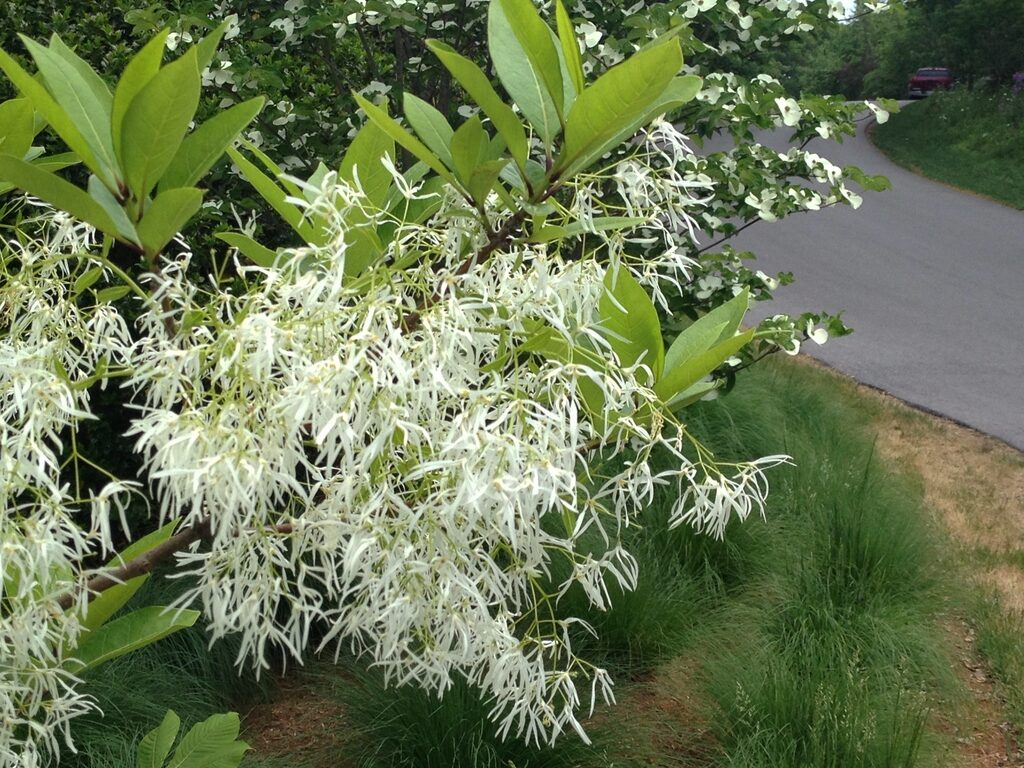White Fringe Tree
go.ncsu.edu/readext?860094
en Español / em Português
El inglés es el idioma de control de esta página. En la medida en que haya algún conflicto entre la traducción al inglés y la traducción, el inglés prevalece.
Al hacer clic en el enlace de traducción se activa un servicio de traducción gratuito para convertir la página al español. Al igual que con cualquier traducción por Internet, la conversión no es sensible al contexto y puede que no traduzca el texto en su significado original. NC State Extension no garantiza la exactitud del texto traducido. Por favor, tenga en cuenta que algunas aplicaciones y/o servicios pueden no funcionar como se espera cuando se traducen.
Português
Inglês é o idioma de controle desta página. Na medida que haja algum conflito entre o texto original em Inglês e a tradução, o Inglês prevalece.
Ao clicar no link de tradução, um serviço gratuito de tradução será ativado para converter a página para o Português. Como em qualquer tradução pela internet, a conversão não é sensivel ao contexto e pode não ocorrer a tradução para o significado orginal. O serviço de Extensão da Carolina do Norte (NC State Extension) não garante a exatidão do texto traduzido. Por favor, observe que algumas funções ou serviços podem não funcionar como esperado após a tradução.
English
English is the controlling language of this page. To the extent there is any conflict between the English text and the translation, English controls.
Clicking on the translation link activates a free translation service to convert the page to Spanish. As with any Internet translation, the conversion is not context-sensitive and may not translate the text to its original meaning. NC State Extension does not guarantee the accuracy of the translated text. Please note that some applications and/or services may not function as expected when translated.
Collapse ▲White Fringe Tree (Chionanthus virginicus) is also known as Old-man’s-beard, or sometimes as Gray-beard. It grows native in the eastern and southern United States as a large deciduous shrub or a dense, round-headed small tree, usually with multiple trunks. Under good growing conditions, trees may reach about 30’ in height.
 The White Fringe Tree has thick, stiff twigs that bear long (4 to 8”) oblong leaves. These deciduous plants can be dioecious, meaning they have only male or female flowers on an individual plant. They can also be polygamo-dioecious where one plant can have female and bisexual flowers and another plant has male flowers and bisexual flowers. Flowers are produced before new growth around May in 8” long flower sprays. The individual flowers have four narrow white petals that are 1 to 1 ½” long. The plant is particularly showy when covered with the large, airy panicles of white flowers. Flowers are followed by green fruit, called drupes, that turn dark blue when ripe, resembling ½” long olives.
The White Fringe Tree has thick, stiff twigs that bear long (4 to 8”) oblong leaves. These deciduous plants can be dioecious, meaning they have only male or female flowers on an individual plant. They can also be polygamo-dioecious where one plant can have female and bisexual flowers and another plant has male flowers and bisexual flowers. Flowers are produced before new growth around May in 8” long flower sprays. The individual flowers have four narrow white petals that are 1 to 1 ½” long. The plant is particularly showy when covered with the large, airy panicles of white flowers. Flowers are followed by green fruit, called drupes, that turn dark blue when ripe, resembling ½” long olives.
Fringe tree occurs naturally in rich loamy soil in woods and along streams. It is tolerant of a wide range of conditions from full sun to partial shade. The best flowers are produced when the plant is in full sun. Its bold, dark green foliage is attractive in summer, and is moderately showy in autumn when the fruits are ripe. Depending on the individual plant, its location, and the year fall color can vary from a yellowish green-brown to a bright golden yellow.
This tree is one of our native plants that is not used in the landscape as often as it should be. You can find this plant in botanical gardens, arboretums, and at native plant sales and garden centers who carry native plants. It makes an excellent small specimen tree with single or multiple trunks and is a show-stopper when it is in bloom if planted as a single tree surrounded by lawn.




